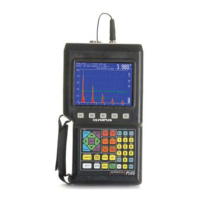36
EPOCH 4PLUS
2. Use the function keys for direct access or the [] and [] keys to toggle through the
four available damping selections.
4.4.4 Test Mode
The EPOCH 4PLUS can operate in three test modes:
Pulse-Echo Mode: Single element transducers. Use either transducer
connector.
Through Mode: Two separate transducers, typically on opposite sides of
the test specimen. Use the red transducer connector as
the transmitter.
Dual Mode (Pitch and Catch): One connector acts as a transmitter; the other acts as a
receiver. The red transducer connector is designated as
the transmitter.
To select a Test mode, follow these steps:
1. Press [PULSER] to access the test mode parameter.
2. Use the function keys for direct access or the [] and [] keys to toggle through the
three selections.
Note: To compensate for the one-way soundpath in Through mode, the EPOCH
4PLUS does not divide transit time by two when calculating thickness
measurements.
4.4.5 Narrowband Filters
The EPOCH 4PLUS has a 25 MHz bandwidth at –3 dB (broadband frequency spectrum).
The instrument can operate in either broadband mode or can use one of many narrowband
filters. Filters improve signal-to-noise ratio by filtering out unwanted low or high
frequency noise outside the test frequency spectrum.
The EPOCH 4PLUS user interface for the filter selection varies depending on whether
you are in Standard User or Advanced User mode (See Advanced User on page 26).
Standard User Mode
In the Standard User mode, you can choose one of nine preset selections. Generally, the
best results are found by filtering out frequencies below and above the selected transducer
frequency. The filter selection is saved in the instrument's datalogger when the entire
waveform/calibration is saved. The appropriate filter selection is recalled when the
waveform/calibration is recalled to the live screen.
For example, if you are using a 10 MHz transducer, select the 8.0–12.0 MHz filter for best
results. Sometimes, the transducer frequency falls between several preset selections. We
recommend that you couple the transducer to a known standard and then adjust the filter
selection until the best signal-to-noise ratio for the desired echo is achieved.
The Broadband selection means that the entire frequency spectrum is analyzed. This
setting is appropriate when you do not want to adjust the filters when either changing

